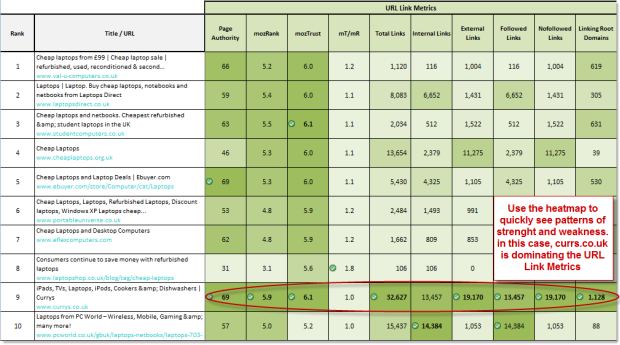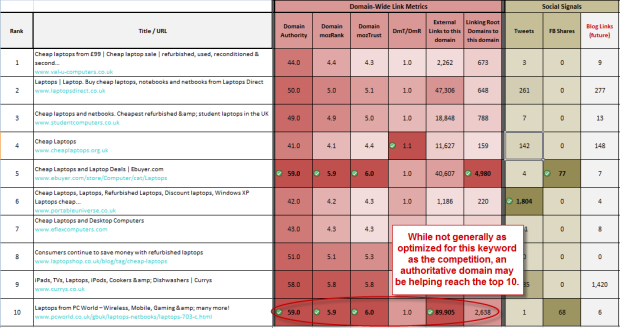
SEOmoz Feature Preview: The SERP Analysis Report (Please Share Your Feedback!)
The author's views are entirely their own (excluding the unlikely event of hypnosis) and may not always reflect the views of Moz.
First of all, thanks to everyone who played along with our little April Fool's prank a couple of weeks back. I apologize if we made our fake Future Rank tool seem a little too real. As penance, I thought I would offer a sneak peek at an actual upcoming feature that is still in the advanced planning stages.
So, What Is It?
The SERP Analysis report is a deep and detailed report that shows the top ten ranking URLs for a particular keyword, retrieves a breadth of potential ranking signals, and presents them in a format that is easy to analyze at a glance. The tool is meant to help SEOs better compare and analyze the factors that may lie behind why particular sites rank in the top ten for certain keywords.
The selection of metrics and format for this report is largely based on the SERPs analysis worksheets that we shared as part of Rand's December post 6 New Tools Every SEO Should Check Out.
Which Metrics Do We Plan to Include?
At the moment, the plan for V1 is to include the following metrics:
- URL Link Metrics
- Page Authority
- mozRank
- mozTrust
- mozTrust / mozRank (Low scores can help identify spammy sites)
- Total Links
- Internal Links
- External Links
- Followed Links
- Nofollowed Links
- Linking Root domains
- On-Page Optimization
- On-Page Analysis Grade (Grade returned after running and on-page keyword analysis report)
- Broad Keyword Usage In Title
- Broad Keyword Usage in Document
- Keyword Used in URL
- LDA Score (future)
- Domain Name Keyword Match
- Exact Match Keyword In Domain
- Broad Match Keyword In Domain
- URL Anchor Text Metrics
- Links with Exact Anchor Text Match
- % of Links with Exact Anchor Text Match
- Linking Root Domains with Exact Anchor Text Match
- % of Linking Root Domains with Exact Anchor Text Match
- Links with Partial Anchor Text Match
- % of Links with Partial Anchor Text Match
- Linking Root Domains with Partial Anchor Text Match
- %Linking Root Domains with Partial Anchor Text Match
- Root Domain-Wide Metrics
- Domain Authority
- Domain mozRank
- Domain mozTrust
- Domain mozTrust / Domain mozRank
- External Links to the Domain
- Linking Root Domains Linking to this Domain
- Social Signals
- Tweets
- FaceBook Shares
- Blog Links (Future)
What Will It Look Like?
Well, this isn't exactly what the full user interface will look like, but this is the format we plan to use within the report. I've included a tiny version of the full report at the top (with a link to the complete spreadsheet), and broken it down below. (Note: the data is old, and a bit munged, but accurate enough to offer a flavor for what we plan to build.)
Warning: you may have to pull out your reading glasses to see this onscreen. (I recommend hitting ctrl-+ in your browser window a couple of times.)
First here is the full metrics sheet:
(Ok, I don't actually expect you to be able to read this, you can download the full spreadsheet here.)
Here is a slightly larger breakdown with a few observations added:




While the metrics for a single section often won't answer the question "why is that ranking first?", looking holistically at all of them will do that most of the time. For example, I was looking at the ninth-ranking result, noting that it seemed to dominate most of the link metrics, and wondered why it ranked below its competitors. Looking further to on-page metrics, it was easy to see that this page has not optimized for the keyword, which is probably why it falls where it does (and why it might improve if the site owner decided to focus on the keyword on-page).
Showing Summary Results
Since it will likely take some time to generate a full report, we plan to also show a summary of data as a quick view. The version we have planned at the moment includes the following elements:
- Page Authority
- Total Links
- Linking Root Domains
- Domain Authority
- Percent of Linking Root Domains with Exact Match Anchor Text
It would look something like this:

This does not include all of the metrics that I would want to include, like on-page score or social metrics, but these should all be retrievable real-time and provide some high-level value before the full report is run.
Why Build a Tool To Generate These Reports?
I've heard from many SEOs that one of their more time-consuming tasks is generating complex spreadsheets to analyze why certain sites are ranking well for specific SERPs and to discover opportunities to improve a target site's ranking. For many, this has proven to be a tedious process of data gathering from multiple sources followed by lots of data entry. Our goal is to take the manual work out of creating these reports and provide that data in an easily consumable way.
Why Are Certain Metrics Missing from This Report?
I imagine that while you were looking through these tables, you noted some important metrics that are absent. Some of these metrics are not ours to provide, like Page Rank. Others are just not ready or available for mass consumption yet, such as LDA score.
Where Will These Reports Live?
We plan to offer this report, both as part of the Keyword Difficulty tool and as a replacement for the basic SERP analysis on the Ranking History Reports in your campaigns.
What Can I Do To Make This Feature Better?
Glad you asked! I'm certain that there are many other great metrics that we could or should include. So if you see something that is totally missing, wonder why in the world we included a certain data point, or think that representing anchor metrics in purple is ridiculous, let us know. We'd love to hear your thoughts!


![How To Drive More Conversions With Fewer Clicks [MozCon 2025 Speaker Series]](https://moz.rankious.com/_moz/images/blog/banners/Mozcon2025_SpeakerBlogHeader_1180x400_RebeccaJackson_London.png?w=580&h=196&auto=compress%2Cformat&fit=crop&dm=1750097440&s=296c25041fd58804005c686dfd07b9d1)

![How To Launch, Grow, and Scale a Community That Supports Your Brand [MozCon 2025 Speaker Series]](https://moz.rankious.com/_moz/images/blog/banners/Mozcon2025_SpeakerBlogHeader_1180x400_Areej-abuali_London.png?w=580&h=196&auto=compress%2Cformat&fit=crop&dm=1747732165&s=d887ee9e0e183cbb2bf4d61c717c2aa3)
Comments
Please keep your comments TAGFEE by following the community etiquette
Comments are closed. Got a burning question? Head to our Q&A section to start a new conversation.